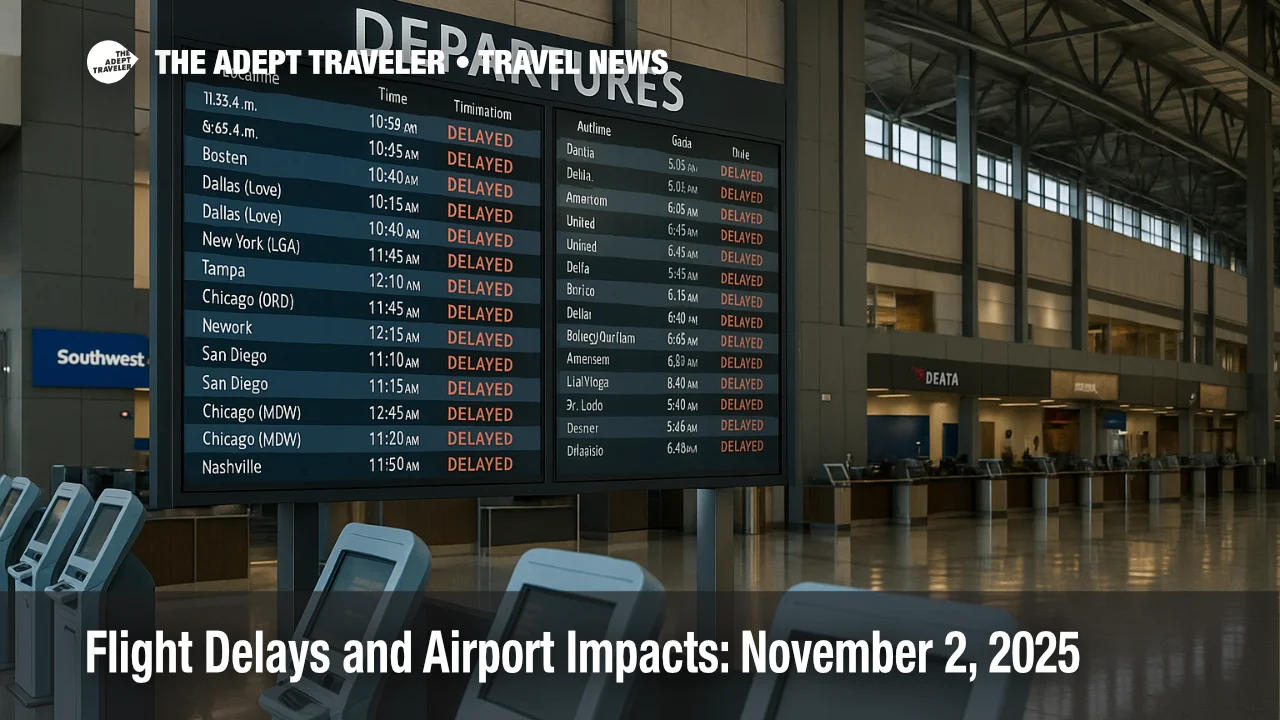Flight Delays and Airport Impacts: November 2, 2025

Key points
- FAA operations plan for November 2 points to targeted programs and staffing triggers
- Austin-Bergstrom is under an FAA arrival ground-delay window this morning
- Overnight GDP at Atlanta tapered before dawn but knock-on spacing may linger
- NAS Status flags possible ground stops or delay programs at Boston, San Diego, and San Francisco this afternoon
- Shutdown-related staffing strain continues to elevate delay risk at select facilities
Impact
- Expect Longer Connection Buffers
- Build at least 90 minutes for domestic connections and two hours for international when connecting through flagged hubs
- Check Your Flight Status Often
- Recheck your flight at T-24, T-12, T-6, and again before leaving for the airport because programs update intra-day
- Use Earlier Departures When Possible
- Morning flights reduce exposure to stacking programs and downstream reroutes
- Know Your Waiver Options
- If your airline issues a travel waiver, move to a flight outside program windows or to a nearby airport with seats
- Plan Airport Transfers Accordingly
- If you are meeting a cruise or tour, allow additional ground time from delayed arrivals
The Federal Aviation Administration's daily operations planning points to another uneven day of delays on Sunday, November 2, as targeted ground-delay programs, staffing triggers, and runway construction constraints put pressure on several hubs. Austin-Bergstrom International Airport (AUS) entered an FAA arrival ground-delay window this morning, while an overnight Ground Delay Program at Hartsfield-Jackson Atlanta International Airport (ATL) tapered before dawn. The National Airspace System Status dashboard also flags potential afternoon programs at Boston Logan International Airport (BOS), San Diego International Airport (SAN), and San Francisco International Airport (SFO), so travelers should build extra buffer time and recheck itineraries frequently.
Where the pressure is
The Air Traffic Control System Command Center's current operations advisories for November 2 call out evolving constraints, including facility staffing triggers and construction-related capacity reductions that can lead to spacing initiatives or ground programs. Although no nationwide Airspace Flow Programs were active at the time of writing, the plan is explicitly time-boxed "02/1500 and later," a reminder that conditions can change by the hour as traffic builds into the afternoon push.
At Austin-Bergstrom, the FAA implemented an arrival Ground Delay Program this morning. By mid-morning, inbound flights were averaging roughly half-hour delays, with the program slated through early afternoon local time. Trips destined for Austin should expect EDCT holds at departure and possible gate-hold pushes, while outbound Austin flights may be less affected.
Atlanta's overnight GDP (covering late Saturday into the early-morning hours Sunday) eased before peak morning banks, but residual spacing from the program cycle can ripple into first-wave connections. If you are connecting through Atlanta today, watch for modest inbound holding and tight cross-concourse connections on itineraries that bank under 60 minutes.
Elsewhere, the FAA's live National Airspace System Status page highlights probable or possible ground stops or ground-delay programs later today for BOS, SAN, and SFO. For Boston, continuing runway work adds complexity during peak arrival periods; West Coast hubs can see compression when coastal low clouds or arrival rate adjustments intersect with weekend traffic. Recheck your flight in the early afternoon if you are booked into any of these airports.
Latest developments
Although weather remains manageable across many regions, the FAA's weekend messaging notes that staffing shortages can trigger flow reductions to maintain safety. That has already produced punctuality hits at several major hubs in the past 48 hours, with Austin, Newark, and Nashville featuring in recent FAA delay tallies. Expect sporadic advisories to continue until federal funding is restored, and watch ATCSCC updates for new GDPs through the evening push.
Analysis
Today's pattern rewards early, nonstop, and longer-connection strategies. If you can move to a first-wave departure, you reduce exposure to afternoon program activations. If you must connect, prioritize itineraries with at least 90 minutes, because GDPs stretch taxi-out, pushback, and arrival spacing, which erodes short buffers.
Background, how FAA programs work A Ground Delay Program (GDP) meters traffic into a constrained airport by assigning departure times at origins, smoothing arrivals to the airport's reduced acceptance rate. Passengers typically see later boarding and longer gate holds at the origin, while the arrival airport appears to operate more normally because demand has been slowed upstream. When facility staffing or weather lowers capacity at a TRACON or Center, the FAA may also issue ground stops or reroutes. Live status, runway closures, and construction notes are maintained by the FAA across the NAS Status and ATCSCC advisory pages, which update throughout the day.
Final thoughts
On November 2, 2025, flight delays are concentrated rather than universal, but the mix of staffing triggers, construction, and time-boxed programs means conditions will shift quickly. Keep your app notifications on, refresh the FAA's NAS Status page periodically, and use earlier, longer-buffered itineraries to navigate today's delay risk.
Sources
- FAA Current Operations Plan Advisory (ATCSCC, Nov 2, 2025)
- FAA National Airspace System (NAS) Status Dashboard, live
- ATCSCC Advisory Log, Nov 1 updates noting AUS delays and BOS GDP cancelation
- Austin: FAA issues arrival ground delay at AUS, 9 a.m.-1 p.m. CT (Austin American-Statesman)
- Austin: FAA arrival ground delay until 1 p.m. CT (CBS Austin)
- Government shutdown: FAA staffing absences driving delays at major hubs (Reuters)
- FAA warns of surge in controller call-outs amid shutdown (Politico)
- AP: LAX ground stop highlights staffing strain during shutdown
